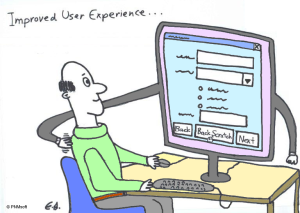Should Technology Force Users to Adopt New Behaviors?
Blog: Colin Crofts - Business Process Improvement
The goal of many business technology projects is to change the way the members of an organization work. This is often because the current mode of work is deemed inefficient, costly or inconsistent. When designing a business technology solution, a major question arises:
1. Should the new solution mirror the way people want to work?
OR
2. Should the new solution reflect how management believes people ought to work?
 The difference between these two approaches is vast. In the first approach, the new technology is simply an enabler. It facilitates your people to work in the way they’d like to work, and is entirely crafted around their comfort zone. The people are leading the technology.
The difference between these two approaches is vast. In the first approach, the new technology is simply an enabler. It facilitates your people to work in the way they’d like to work, and is entirely crafted around their comfort zone. The people are leading the technology.In the second, the organization’s management decides how its employees should be working, and the new technology then forces them to align with these new work practices. Here, the technology is leading the people.
The question is, do the people want to be led?
Each approach has its pros and cons. In 1., the new system may be quite comfortable for its users, but it may not achieve the organization’s goals as far as bottom line and efficiency. In 2., the system may be designed to achieve these goals, but its users may find it too far removed from their learned practices and they may reject its adoption. The awkward fact is that 70% of change initiatives fail (Harvard Business Review).
An example of this could be a customer service process which now requires agents to complete a questionnaire about the customer’s experience after each ticket is closed. This change could provide valuable feedback for the company, but could be an annoyance for the agent.
At PNMsoft, we propose a third, more balanced approach:
3. Begin with the way people want to work, then guide them toward better work practices.
 This means that the initial solution should be closer to how your people want to work (approach 1. ), with some low-effort, high impact changes that reflect management goals. Then, as time progresses, the solution should be modified incrementally, guiding workers toward practices that will benefit the organization as a whole. This way, workers will find the initial adoption of the system easier. Then, they will gradually be led toward change, step-by-step, toward practices that align with the business’s success.
This means that the initial solution should be closer to how your people want to work (approach 1. ), with some low-effort, high impact changes that reflect management goals. Then, as time progresses, the solution should be modified incrementally, guiding workers toward practices that will benefit the organization as a whole. This way, workers will find the initial adoption of the system easier. Then, they will gradually be led toward change, step-by-step, toward practices that align with the business’s success.This is a “Small Steps, Big Change” approach that progresses and improves over time. It can be made possible using PNMsoft’s HotChange® technology and Evolutionary BPM methodology. See this article by PNMsoft CEO Gal Horvitz for more on the topic of technology that takes human aversion to change into account.
Case Management technology is an excellent example of where the third approach works well. Case workers tend to be experts in their field – these are ‘knowledge workers’ who may have strong ideas about how they want to work. They may stubbornly resist change. Still, even an expert can be led toward more optimal work practices that also have the organization’s well-being in mind. In a Case Management Software solution, designing a solution that fits the Knowledge Worker’s work style, but also guides him toward ever-improving work practices is of prime importance to the business outcome.
But is it feasible to deploy a solution that changes over time? The answer is not just, yes it’s feasible, but on the contrary, it’s imperative! In today’s ever-changing business environment, technology solutions must change over time in order to keep up with a dynamic, competitive marketplace. Your business climate is constantly changing, and your solution must be flexible enough to adapt to these changes, or be left behind.
Feedback Sessions
When adopting the third approach – the Guided Change approach – it’s important to involve users and management in the planning of each stage of the solution. Listen closely to the feedback in these sessions, and pick and choose carefully which elements to mold according to existing practice, and which to change to meet management expectations.
 User Experience
User Experience
When making changes, try to assimilate them into the system in a way which is intuitive and friendly, and doesn’t make workers go out of their way, grumbling. This is the place to involve a UX (User Experience) expert. UX isn’t just about the experience of your customers. UX is equally important for your own workforce. Optimal UX takes into account what is most natural for the human user, and makes the pill of change go down more easily.
In the Customer Service example we provided earlier, this might mean adding inline customer mood indicators to existing forms, instead of making the agent fill out an onerous questionnaire.
Organizational change is not simple. These are just some tips from a greater methodology for implementing technology change effectively. We hope that they’ve opened up your thinking on how to go about your technology change initiative.
PNMsoft provides BPM (Business Process Management) solutions which guide organizations toward business transformation. We’d be happy to help you guide your organization toward Transformational Change. Contact us below to arrange a consultation.
Leave a Comment
You must be logged in to post a comment.







